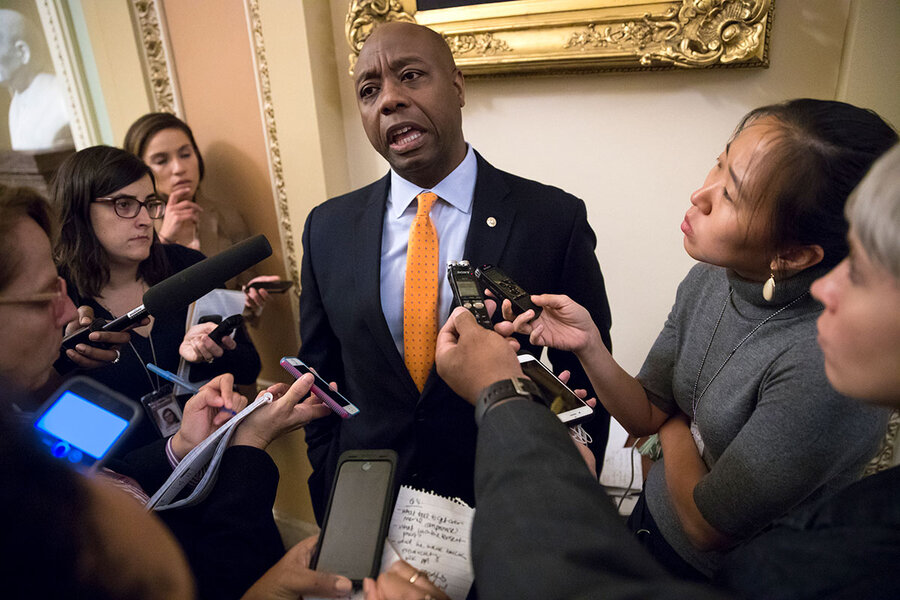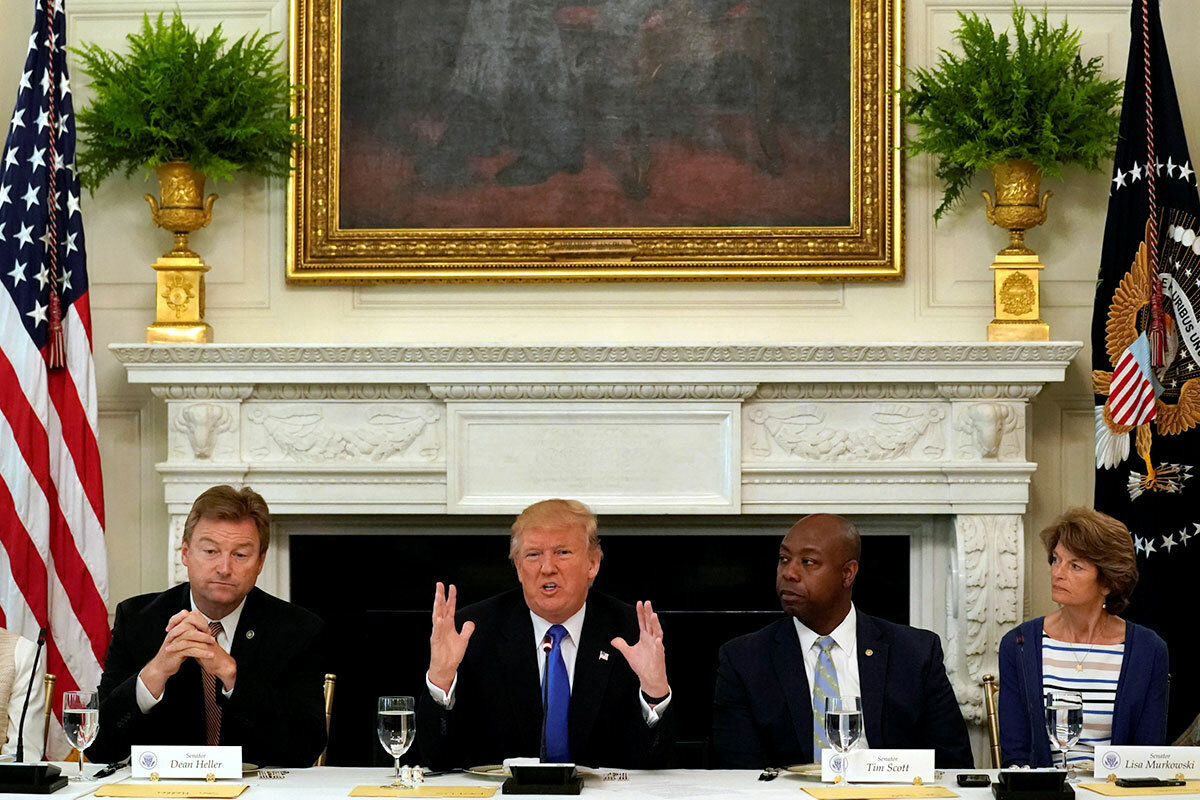Bridging the racial divide: One step forward or two steps back?
Loading...
| Washington
When Sen. Cory Booker, the Democrat from New Jersey, heard that his Republican colleague Tim Scott of South Carolina was meeting with President Trump to discuss racial issues in the wake of last month’s violence in Charlottesville, his initial reaction was: “God bless him for even trying.”
Like many in the African-American community, Senators Booker and Scott were both deeply offended by Mr. Trump’s statements casting blame on both sides for the tragic events that led to the death of one woman, and appearing to put white supremacists on an equal moral footing with those who oppose them. Mr. Scott, the only black Republican in the Senate – and a Trump supporter during the general election campaign – publicly accused the president of having compromised his “moral authority.”
So when Scott agreed to meet with Trump at the White House this week to talk through all this, Booker was admiring but not particularly hopeful. Still, he understood Scott’s motivation: “The more you know people who are different than you, the more that does ignite the capacity for empathy and compassion.”
It's true that personal connections have always been a powerful force in Washington. Friendships across the aisle can help pave the way for progress on some of the thorniest issues. For a president living in the White House “bubble,” having a diversity of voices around can be critical.
But in the current highly charged, whipsaw political environment, achieving a meaningful shift in perspective – or even dialogue – on an issue as sensitive and emotional as race seems harder than ever. Indeed, a CBS News poll last month showed that while 82 percent of Democrats disapproved of the president’s response to Charlottesville, 67 percent of Republicans approved of it. Likewise, when a Fox News poll asked if Trump “respects racial minorities,” 82 percent of Republicans said yes; 92 percent of Democrats said no.
That divide might help explain why Trump would – all in a matter of days – hold a much-publicized meeting with Scott, sign a joint resolution of Congress condemning the violence in Charlottesville and white supremacists in general, and then double down on his original comments that “both sides” were to blame. As a result, an opportunity for greater understanding appeared to lead instead to more controversy.
On Wednesday, Scott came away from his Oval Office meeting “encouraged” by the president’s “attentive” listening. He told reporters he believed the president “got” his point that there can be no equivalence between white supremacists, with their centuries-long history of horrific treatment of minorities in this country, and today’s “antifa” – the violent anti-fascists confronting hate groups.
But that sense of connection would prove short-lived, as Trump just a day later reiterated his original comments, saying there are “bad dudes on the other side.” Since Charlottesville, Trump told reporters Thursday, “A lot of people are saying – in fact a lot of people have actually written, ‘Gee Trump might have a point.’ I said, you got some very bad people on the other side also, which is true.”
“Rome wasn’t built in a day, and to expect the president’s rhetoric to change based on one 30-minute conversation is unrealistic,” Scott’s office responded in a statement. His spokesperson said the senator was still pleased with the president’s commitment to diversifying his staff and supporting the senator’s “Opportunity Act,” which seeks to help poor and minority communities.
Scott's perspective
During his meeting with the president, Scott made a point of sharing his personal story. As he said on CBS’s “Face the Nation” last month, the president needs to have a “personal connection to the painful history of racism and bigotry in this country.”
Scott’s story is compelling. He and his siblings grew up poor in North Charleston, S.C., raised by a strong single mom who worked 16-hour days as a nurse’s assistant.
For a time, they lived with her parents in a tiny rental house on a dirt road. His grandfather, who never learned to read, picked cotton most of his life. When Scott drove him to vote for President Obama in 2008, he said he had tears in his eyes.
The young Scott nearly flunked out of high school, but was mentored by the owner of a Chick-fil-A franchise next to the movie theater where he worked. The owner hammered home the value of hard work and personal discipline. After college, Scott got into the insurance and real estate businesses.
Yet even now, after more than two decades in politics, he routinely gets stopped by law enforcement – a point he shared with Trump.
In a series of stirring Senate speeches on race in 2016, Scott described being pulled over by police seven times in one year, and being denied entry into congressional buildings even while wearing his member’s pin on his lapel.
“The officer looked at me with a little attitude and said, ‘The pin, I know. You, I don’t. Show me your ID,’ ” he said.
But while a story like this is undeniably powerful, many remain skeptical of its power to change Trump’s overall approach to racial issues.
“I don’t think it ever hurts for somebody to speak to the president about important issues like this,” says Ron Lester, a veteran Democratic pollster and an African-American. But he rejects the idea that the president’s divisive remarks can simply be attributed to a lack of contact with minorities. Trump “knows what he’s doing. He knows who he’s playing to” in his base of white supporters.
“Anybody who grows up in Queens and lives in New York for 70 years knows a lot of black people, knows a lot of Latino people, knows a lot of gay people,” Mr. Lester points out.
Knowing versus understanding
Over the years, Trump has counted a number of black celebrities and star athletes as his friends, from basketball talent Dennis Rodman, to boxing promoter Don King and hip-hop mogul Russell Simmons (although in 2015, Mr. Simmons broke with then-candidate Trump over his so-called Muslim ban). The president’s housing secretary, Ben Carson, is African-American, as is White House aide Omarosa Manigault.
But while the president may have had plenty of contact with African-Americans over the years, that’s not the same as understanding them or their history. “There’s a difference between knowing black people and socializing with them. I think the president socializes with a lot of black people, but I don’t think they are his true friends,” says Raynard Jackson, a Republican consultant and head of a political action committee that aims to bring more African-Americans into the GOP.
Mr. Jackson says it’s unfair that Trump has been labeled a racist. The president has simply “made the sin that most leaders made – they discounted a whole body of people’s feelings.”
Regardless of how the president’s words come out or are meant, they are interpreted based on the experiences of those who hear them. “In his mind,” says Jackson, the president “may not have said anything he thought was offensive. But to a whole group of black people, they are.”
More minority staff needed
What Trump needs, says Jackson, is closer relationships with African-Americans who will give him honest, hard-to-hear feedback.
Scott says he discussed with the president the importance of “diversifying those in the echo chamber” by adding those who may “think differently” – particularly by hiring more minority staff members.
After all, small steps can sometimes lead to bigger changes. Scott often points to his own election to the US House from a district that heard the first shots of the Civil War – and where he defeated the son of the late Sen. Strom Thurmond, a one-time segregationist – as first-hand evidence that change is possible.
As for restoring the president’s moral authority, that “will be based on America’s reaction," Scott says. "And it will take time.”







